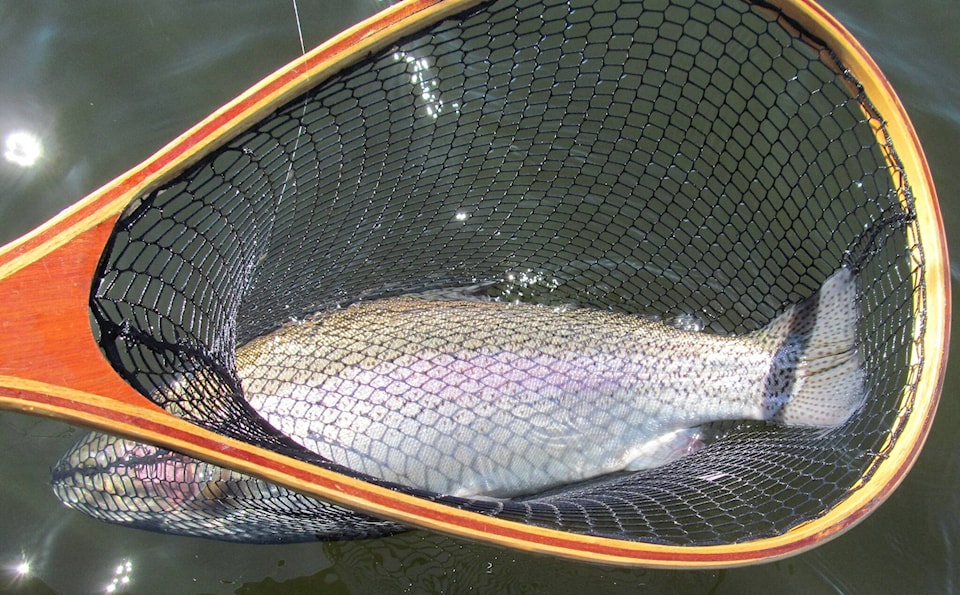Fishing for Rainbow Trout has long been a passion of mine, since catching my first one at the age of six.
I have pursued them with bait, lure, and fly in that order. One thing I learned a while back was that all rainbows are not the same, and there are several strains of them, named for the location the broodstock was collected from.
I checked on the recent stocking of a number of local lakes by going on a site provided by the Freshwater Fisheries Society of BC at https://www.gofishbc.com/stocked-fish/ and choosing what information I wanted detailed in a report. For instance, by choosing a region and stocking date, a report can be generated showing all the different species stocked.
The one I generated for 2022 for the Cariboo Region Lakes showed the waterbody name, the nearest town, species, strain, genotype, life stage, average size, and quantity of the fish stocked. The report showed that there were five strains of rainbow species noted, they were: Dragon, Pennask, Blackwater River, Fraser Valley, and Horsefly River.
There is obviously a different lake management strategy involved in choosing what species to stock where. For example, if there are lake chubs or red side shiners, whose population needs to be controlled, the strain choice would be between either the Blackwater River or Horsefly River strain.
Both these strains, once they reach a certain size, will begin to forage on the minnows (become piscivorous). The Fraser Valley strain is usually stocked in lakes following the winter kill of a lake to sort of jump-start the fishing in that body of water. They are usually of a size large enough to keep (referred to as catchables).
I will provide a brief summary of four of these strains taken from a report titled “Rainbow Trout Strains Currently Stocked in BC Waters” dated January 2004, produced by The Freshwater Fisheries Society of BC, and further information found on the gofishbc website mentioned earlier.
Pennask
“They are most successful when stocked into highly productive monoculture lakes” as they do not compete well with other species and are not highly piscivorous. “They feed primarily on benthic organisms such as chironomid pupae and are most active at dusk.”
However, like all species of rainbows, it has been my experience that they are opportunistic and will forage on whatever aquatic organism is most abundant in a lake environment. They prefer the open water in lakes, as opposed to the Blackwater and Horsefly River strains which are shoal foragers. The Pennask strain is much sought after for its aggressive behaviour, “fighting ability and tendency to jump when hooked.”
They are easily recognized as most of their spots are located above the lateral line (located approximately half ways between the back and belly of the fish running from the gills to the tail).
Blackwater River
These are fast-growing, heavily spotted fish that are good fighters and easily targeted due to their aggressive foraging behaviour mostly on the shoals seeking out larger prey such as dragonfly nymphs, snails, crustaceans (shrimp), and non-salmonid fish. They are known to turn piscivorous as early as one year in age. This strain is more active in the daytime than the other strains
Fraser Valley
These fish are heavily spotted on the tail and body, have a wide girth, and are fast growing as well. They are strong fighters but are not known for jumping. They do best in productive lakes feeding on a range of aquatic insects where they can reach a large size.
Horsefly River
These latest additions to the current stockings are highly aggressive, rapidly growing, great fighters, and very competitive. They are omnivores, feeding on most aquatic organisms found on the shoals where they actively forage. Like the Blackwater River strain, they too become piscivorous at an early age.
These fish are known to live almost twice as long as most other strains, providing ample opportunity to grow quite large. As they mature, they are best targeted with lures or spoons representing baitfish.
Since I like closing with a quote, I will, at risk of being banned from the paper, state emphatically “it is not the size of fish in the fight, but the size of the fight in the fish”.
